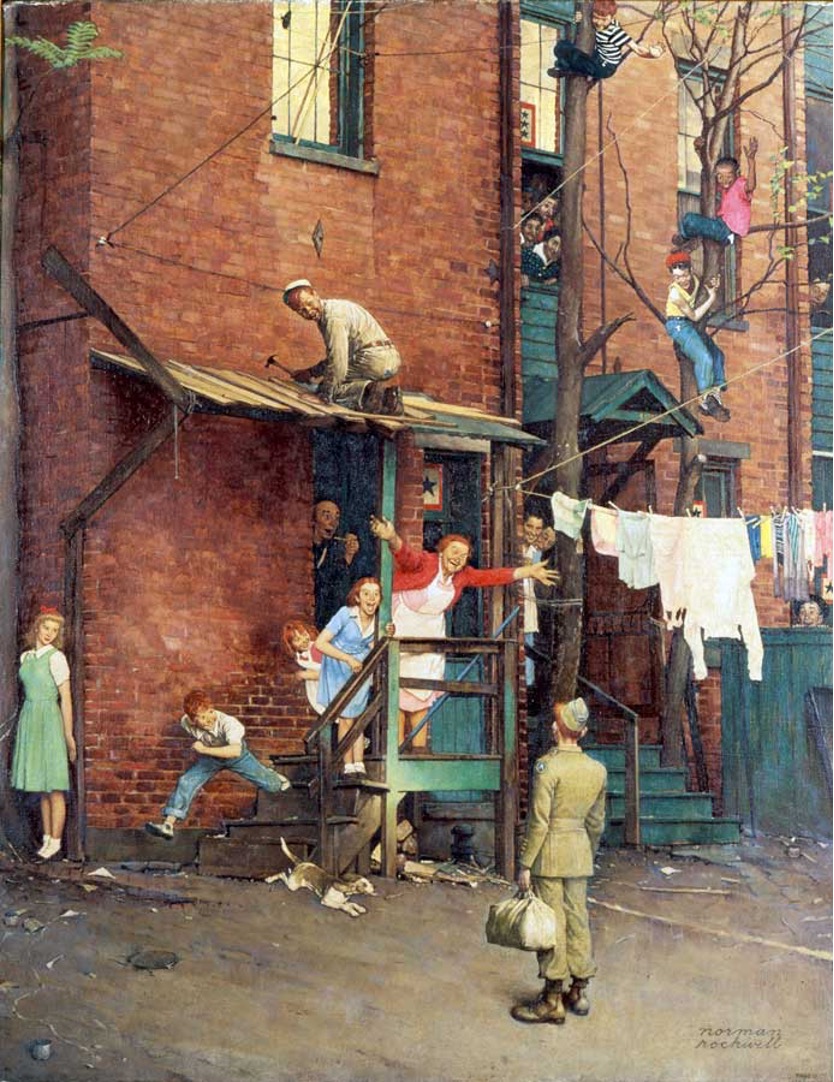Quick Pics: Homecoming Soldier (week of November 9, 2020)
Homecoming Soldier (1945)
Cover illustration for The Saturday Evening Post, May 26, 1945
Big ideas and Vocabulary
Love, service, family, neighborhood, home
Notice and Wonder
- What is the setting?
- How would you describe the building? What do you see hanging from a line?
- Who are the characters? Whom do you notice in the stairwell? In the tree? Around the corner?
- Who is the person in uniform?
- What emotions do the characters express? How does the image make you feel?
- Look closely at the woman leaning out of the doorway with open arms. Who do you think she is? Why do you think Rockwell chose the color red shirt for her shirt?
- How would you describe the story this image tells?
Fun Facts
- During World War II, Norman Rockwell’s portrayals of soldiers on the American home front were a reassuring presence in the popular press during trying times.
- Norman Rockwell received many fan letters from Saturday Evening Post readers who appreciated Rockwell’s artistry and the stories that he chose to tell, and his portrayal of a GI returning home to an overjoyed community of family, friends and neighbors received rave reviews. “The picture is an instance of American humanity at its best,” wrote Mr. and Mrs. M. Epstein in a May 26, 1945 letter, and another from Mrs. Grace W. Page said, “Your cover of the May 26th Saturday Evening Post is wonderful. The family resemblances…the returning soldier, the neighbors of all nations looking out to greet him―even the old-fashioned screen door―are perfect. But there’s one thing lacking―there should have been a cat rubbing against the soldier’s legs…evidently purring loudly.”
- Set in an urban courtyard in Troy, New York, the painting features many models who were not actually on site that day. Most posed individually in Rockwell’s Arlington, Vermont studio, where he carefully choreographed his composition.
- The building in this image is a multi-family home. Different families live on different floors.
- Stars in the upstairs window convey three members of the family are serving in the military.
- Norman Rockwell uses the color red as a focal point. The mother’s shirt, the red hair on family members, serve as focal points
What you can do
Think about examples of service and care where you live and go to school. Do you know anyone who serves in the military? How do you and the people you live with show care and appreciation?
Draw an image that shows excitement and expresses care for another person. What is the story behind your image?
Image Resources
Homecoming Solider (1945)
Image Credits:
Homecoming Soldier, 1945
Norman Rockwell (1894 - 1978)
Oil on canvas
Cover illustration for The Saturday Evening Post, May 16, 1945
© 1945 SEPS Curtis Licensing, Indianapolis, IN.
- Grade
- K-6
- Theme
- Quick Pics
- Length
- Each Quick Pic activity is about 5-10 minutes in duration, with each being taught one image per day over a week.
- Discipline
- Social Studies, Language Arts: Speaking and Listening, Art
- Vocabulary
- Hero; Heroes, Solider, Love, Service, Family, Neighborhood, Home
Standards
This curriculum meets the standards listed below. Look for more details on these standards please visit: ELA and Math Standards, Social Studies Standards, Visual Arts Standards.
- CCSS.ELA-Literacy.CCRA.L.1
- Demonstrate command of the conventions of standard English grammar and usage when writing or speaking.
- CCSS.ELA-Literacy.CCRA.L.2
- Demonstrate command of the conventions of standard English capitalization, punctuation, and spelling when writing.
- CCSS.ELA-Literacy.CCRA.L.3
- Apply knowledge of language to understand how language functions in different contexts, to make effective choices for meaning or style, and to comprehend more fully when reading or listening.
- CCSS.ELA-Literacy.CCRA.L.4
- Determine or clarify the meaning of unknown and multiple-meaning words and phrases by using context clues, analyzing meaningful word parts, and consulting general and specialized reference materials, as appropriate.
- CCSS.ELA-Literacy.CCRA.L.5
- Demonstrate understanding of figurative language, word relationships, and nuances in word meanings.
- CCSS.ELA-Literacy.CCRA.L.6
- Acquire and use accurately a range of general academic and domain-specific words and phrases sufficient for reading, writing, speaking, and listening at the college and career readiness level; demonstrate independence in gathering vocabulary knowledge when encountering an unknown term important to comprehension or expression.
- CCSS.ELA-Literacy.CCRA.SL.1
- Prepare for and participate effectively in a range of conversations and collaborations with diverse partners, building on others' ideas and expressing their own clearly and persuasively.
- CCSS.ELA-Literacy.CCRA.SL.2
- Integrate and evaluate information presented in diverse media and formats, including visually, quantitatively, and orally.
- CCSS.ELA-Literacy.CCRA.SL.3
- Evaluate a speaker's point of view, reasoning, and use of evidence and rhetoric.
- CCSS.ELA-Literacy.CCRA.SL.4
- Present information, findings, and supporting evidence such that listeners can follow the line of reasoning and the organization, development, and style are appropriate to task, purpose, and audience.
- CCSS.ELA-Literacy.CCRA.SL.5
- Make strategic use of digital media and visual displays of data to express information and enhance understanding of presentations.
- CCSS.ELA-Literacy.CCRA.SL.6
- Adapt speech to a variety of contexts and communicative tasks, demonstrating command of formal English when indicated or appropriate.
